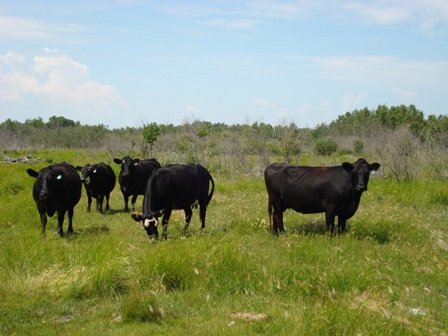Grazing Considerations for Sensitive Land
Spring time is generally viewed as the time when the grazing system starts its new cycle. The first spring ‘green up’ tempts producers to let the cows go. But it can cause major implications later on in the growing season. Here are some considerations to think about as grazing begins this summer.
The spring growth is the time when the plants are setting up and preparing for the upcoming growing season. This is when good management can have the greatest effect on production and length of the grazing season. The rule of thumb is that pastures should not be grazed until the plants are at the four-leaf stage. At this point the plant has had enough time to prepare the root system and have adequate leaf area to maintain growth throughout the summer.
Grazing prior to the four-leaf stage depletes those important root reserves and minimizes the leaf area available for photosynthesis and growth. Grazing one week too early in the spring will sacrifice three weeks of grazing in the fall. This rule of thumb should be used on all types of native or tame grass pasture.

Riparian areas
A riparian area is the land between the water and the drier upland. Spring is typically the time when these water bodies are the fullest, making riparian areas most sensitive to early grazing. Excess moisture increases the impacts of hoof action and water quality around sloughs, creeks and low lying areas.
It is best to avoid grazing these areas too early. When grazing riparian areas, grazing must be limited in duration and frequency to allow the plants time to recover. Where possible, fence riparian areas separate from drier areas to manage appropriately.
Salinity management
Salinity is a water management issue. Forages use more water than annuals and can be a good tool to manage saline areas. Plant deep-rooted perennial forages such as alfalfa in recharge areas to use large quantities of soil moisture thereby preventing excess water from moving into the water table.
Soil testing can be done for salinity to aid in forage selection for planting. Plant salt tolerant perennial forages such as wheatgrass or tall fescue in the saline area to encourage uptake of soil water despite the presence of salts. Salts will then be left below the rooting zone thereby improving the growing conditions for forages and crops. Grazing of these areas should be managed as riparian areas noted above.
Native forages
Native forages grow very slowly in the spring. If they’re grazed before June 1, only about 60 per cent of the potential yield will be obtained since the majority of their growth occurs from late May to mid-June.
Delaying the grazing of the native species untill mid-June can increase the productivity of the native grasses by over 25 per cent.
Importance of rest
Forage plants need at least 30 growing days of rest in order to re-grow properly and replenish nutrient reserves. Don’t over graze; leave two to six inches of plant material behind to ensure the plants continue to grow. The more leaf area left behind the more photosynthetic material is available to replenish nutrient reserves.
Over grazing is a function of timing and duration of grazing. It occurs when the plant is grazed before it has had adequate time to recover from the previous grazing.
Plan ahead
In the spring, most cattle are calving, which is the production phase where their nutritional requirements are the highest. It is important to consider the requirements of the cattle as well as the requirements of the pasture. If using a sacrifice pasture early in the spring, ensure supplemental feed is provided to the cattle. This will help alleviate some of the grazing pressure on the grasses and ensure cattle are having their nutritional requirements met. The same can be said if using stockpiled spring pastures.
The growth left over from the previous year is very low in quality, thus requiring supplemental energy for the cattle. here are other options for early spring grazing such as winter cereals or early grass varieties such as crested wheat grass. These practices require planning ahead. So this summer and fall, start thinking about your spring grazing management plan for next year.
Other related links

